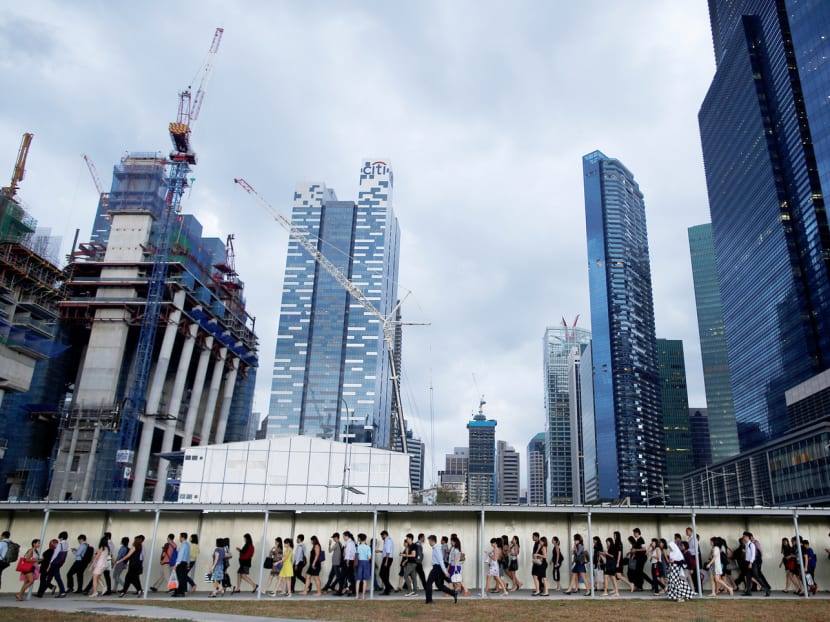‘Ageing workforce, tech disruption could bump up jobless rate’
SINGAPORE — With the ageing workforce expected to cause Singapore’s unemployment rate to creep up, economists yesterday noted that the Republic could be hit by a double whammy, given that technological disruption would affect mature workers the most and make it even harder for them to find new jobs.
SINGAPORE — With the ageing workforce expected to cause Singapore’s unemployment rate to creep up, economists yesterday noted that the Republic could be hit by a double whammy, given that technological disruption would affect mature workers the most and make it even harder for them to find new jobs.
However, barring a recession, they do not expect unemployment rates to reach the highs seen during the severe acute respiratory syndrome (Sars) epidemic in 2003 (4.8 per cent) and the global financial crisis less than a decade ago (3.3 per cent).
CIMB Private Banking economist Song Seng Wun said it takes a longer time to reverse unemployment in an economy with an ageing workforce: “Any external shock, obviously, would have a bigger shock and, perhaps, (it is) also harder to rebound (from it).”
He said older professionals, managers, executives and technicians (PMETs) would bear the brunt of rising unemployment, since businesses tend to let go of older workers who may be more experienced but are costlier to keep, and their skills could be replaced by technology. This is seen in the “juniorisation” of some businesses, he added.
In the past week, government leaders have warned that the unemployment rate in Singapore is set to rise in future, in line with the experiences of developed countries and fuelled by factors such as an ageing workforce.
Nevertheless, Ms Selena Ling, OCBC Bank’s treasury research and strategy head, reiterated that an ageing workforce does not necessarily push unemployment upwards. To prevent this from happening, the economy has to stay competitive, drawing investments and creating jobs with high value. Although the population is ageing, the question is whether workers are productive and can “value-add”, she said.
“It’s not a linear relationship, where the older you are, the less productive or competent you are,” she said.
Ms Ling said that while there is no “quick fix”, government initiatives such as the SkillsFuture movement are a start, although a mindset shift is needed since workers pay little attention to retraining while still holding jobs.
On this point, United Overseas Bank senior economist Alvin Liew said there is still demand on the skills front that retraining cannot meet, such as that for highly skilled data scientists. “You can learn coding, but you may not be able to have the right experience and skills (for) data analytics,” he said.
As the economy and labour market undergo significant shifts, it may be worthwhile revisiting Singapore’s natural rate of unemployment, economists said. This is the rate of unemployment where inflation tends not to rise or fall, and an indicator called the non-accelerating inflation rate of unemployment (Nairu) is one way to measure it.
The Monetary Authority of Singapore (MAS), in its Macroeconomic Review in April 2013, said its estimates pointed to the country’s Nairu possibly dipping from its peak of more than 3 per cent in 2005 and 2006 to below 2.5 per cent in 2012. There are no publicly available official figures on Singapore’s Nairu in recent times.
In that report, the MAS noted that the “elevated rates of job creation and destruction can push the natural rate of unemployment up” during times of “significant structural change in the economy”.
Unemployment due to cyclical factors could also rise, as workers move between industries at a faster pace, resulting not only in higher “frictional unemployment”, but possibly greater “structural unemployment” because of mismatches between jobs and workers’ skills.
Noting that many factors could affect the country’s Nairu, Mr Song said that the natural rate of unemployment here is always “within policymakers’ control” since the Government regulates the foreign-worker supply. How foreign labour is managed has an effect on inflation, given that tightening inflows will cause local wages to rise, causing inflation to creep up.
Government policy in other areas, such as immigration, as well as changing business needs with the rise of the gig economy, also weigh on Nairu, Mr Song said.
Agreeing on the role that technology, including the gig economy, plays, Maybank Kim Eng senior economist Chua Hak Bin said: “(Traditionally) when labour demand picks up, (this) pushes wages up.
“What technology does is flatten out the labour-supply curve, so all changes in wages can incentivise companies to find ways to reduce their dependence on workers.”









